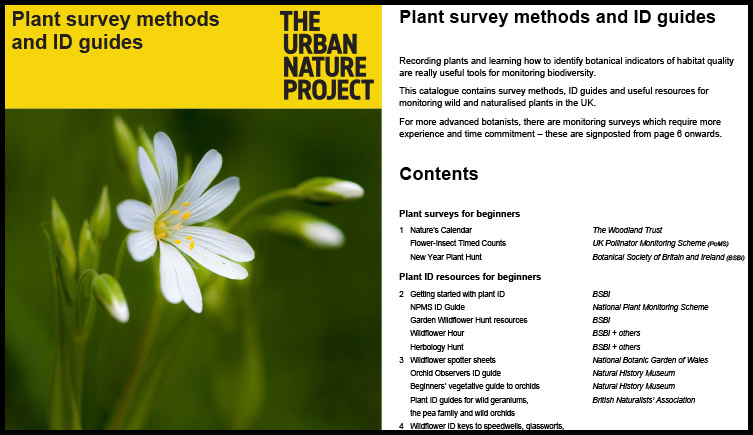Nature Recording Hub
Discover how to record the wildlife in your urban environment.
Recording plants and learning how to identify botanical indicators of habitat quality are really useful tools for monitoring biodiversity.
This catalogue contains survey methods, ID guides and useful resources for monitoring wild and naturalised plants in the UK.
For more advanced botanists, we've also listed monitoring surveys which require more experience and time commitment.
Download the full catalogue (PDF 1.4MB), or read the highlights below.
Discover how to record the wildlife in your urban environment.

Download the full list of plant surveys and ID guides
Botanical Society of Britain and Ireland (BSBI)
A survey to see what plants are flowering in the winter.
When: a four day period over the New Year.
Equipment: plant ID guides, a hand lens would be useful.
Independent but supported by BSBI, Plantlife, The Wild Flower Society, The Wildlife Trusts and The Woodland Trust
If you have found a wildflower you cannot identify, you can post on social media platforms with the tag #wildflowerID where the helpful community will assist with identification.
Developed by BSBI, UK Centre for Ecology and Hydrology, Plantlife and Joint Nature Conservation Committee (JNCC)
You will be randomly allocated a 1km square to visit near you. The survey then involves recording plant indicator species in five plots of semi-natural habitat in your 1km square.
You can either record all vascular plant species or just the indicator species.
You will need to identify between 25-30 indicator species per habitat: these are distinctive species and training can be provided.
When: the survey is done annually in late spring / early summer and again in late summer.
Equipment: The survey will provide guidance, forms, species guides and a map of your kilometre square. You will also need: tape measure or a length of cord marked at 5m intervals, sufficient to mark out 25m or 40m depending on the plot dimension, four corner markers such as tent pegs or bamboo canes, a clipboard, GPS and/or compass, camera, and pencil.